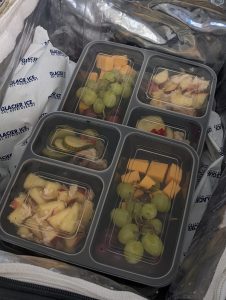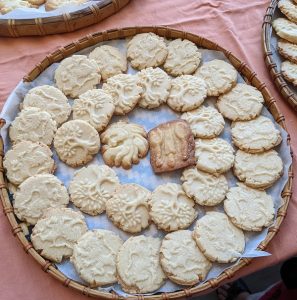As promised in our previous blog post, Lunch for Athenaeum, 2019, here is what we did when the event called Athenaeum again took place in person.
In our mission to serve as a resource for people who participate in the Society for Creative Anachronism (SCA) to become familiar with historical food, we prepared a lunch of medieval-style food for the SCA event, Athenaeum, in the summer of 2022. Mindful of pandemic-time food-handling precautions disseminated by the CDC, we decided that we would replace our previous buffet-style lunch with a box lunch. Using food-service grade chambered trays with lids and large cooler bags to keep portioned food cool at the event space added to the expense. This lunch cost the diners a few dollars more than the lunch we made for the event in 2019.

Attendees who wanted to purchase our lunch were given the means to subscribe in advance, so we knew approximately how many people we had to cook for – although we made extra of everything for the last-minute hungry people.
We dipped into our library of recipes from the 16th and 17th century England, and devised a repast that could be served cold and would portion well into the chambered trays. We prepared:
Sallet of Cold Hen – from “Pepys at Table: 17th Century recipes for the modern cook”
Assorted pickles – from “The Queen-like Closet” by Hannah Wooley. We pickled cucumbers, cauliflower, and mushrooms.
Cubes of cheese
Fresh fruit – red and green grapes
A wheat roll, or gluten-free crackers
Shrewsbury Cakes – from “Banquetting Stuff.” (We made a gluten-free version, too.) We have some cookie cutters with heraldic patterns on them; the An Tir Lion; the populace badge for our Barony, which is a tree; the coat of arms of the Culinary Guild. The cookies were offered on trays and were accessible with tongs, to continue the careful food-handling practices that guided us.
We crafted the menu with options in order to be allergen-friendly. The rolls or crackers were available separately in small compostable paper bags. The salad and pickles were dairy-free. Diners could let us know they desired a lunch tray with no cheese in it.
We prepared the pickled vegetables, the cookies, and the “sallet” in the days just before the event. On the morning of the event, we washed and portioned grapes, and sliced the cheese. We transported all the elements of the meal to the event venue and worked at tables outdoors in a covered space.
Wearing food-handling gloves, we assembled meals in the chambered trays, put clear lids on them, and kept them cool until the lunch break. We served more than 100 lunches to happy participants who did not have to leave the site of an engrossing event in order to obtain a meal.
Success.
